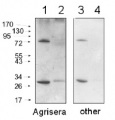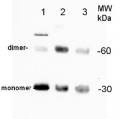1
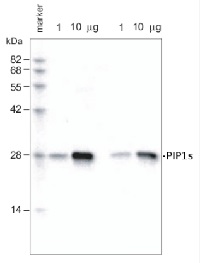
Anti-PIP1;1, PIP1;2, PIP1;3, PIP1;4, PIP1;5 | Aquaporins
AS09 489 | Clonality: Polyclonal | Host: Rabbit | Reactivity: Arabidopsis thaliana, Nicotiana tabacum, Phoenix dactilifera, Raphanus sativus, Zea mays
Replaced by AS22 4816
- Data sheet
-
- Product Info
-
Immunogen: KLH-conjugated synthetic peptide derived from N terminus of Raphanus sativus PAQ1O80368. Chosen peptide is conserved in PIP1;1, PIP1;2, PIP1;3 N-terminus of Raphanus sativus and in all 5 isoforms of Arabidopsis thaliana coded by:AT3G61430.1 (PIP1;1), AT2G45960.3 (PIP1;2), AT1G01620.1 (PIP1;3), AT4G00430.1 (PIP1;4), AT4G23400.1 (PIP1;5)
Host: Rabbit Clonality: Polyclonal Purity: Serum Format: Lyophilized Quantity: 100 µl Reconstitution: For reconstitution add 100 µl of sterile water Storage: Store lyophilized/reconstituted at -20°C; once reconstituted make aliquots to avoid repeated freeze-thaw cycles. Please remember to spin the tubes briefly prior to opening them to avoid any losses that might occur from material adhering to the cap or sides of the tube. For long time storage over 1 year please dilute the antibody solution 10 fold with 10 mM Tris-buffered saline containing 10% glycerol. Glycerol may suppress denaturation of the protein. Tested applications: ELISA (ELISA), Western blot (WB) Recommended dilution: 1 : 8000 (ELISA), 1 : 1000 (WB) Expected | apparent MW: 30.66 | 28 kDa (Raphanus sativus)
- Reactivity
-
Confirmed reactivity: Arabidopsis thaliana, Nicotiana tabacum, Phoenix dactilifera, Raphanus sativus, Zea mays
Predicted reactivity: Lupinus sp. , Hordeum vulgare, Solanu lycopersicum, Ricinus communis, Oryza sativa, Populus trichocarpa
Species of your interest not listed? Contact usNot reactive in: No confirmed exceptions from predicted reactivity are currently known - Application Examples
-
Application example
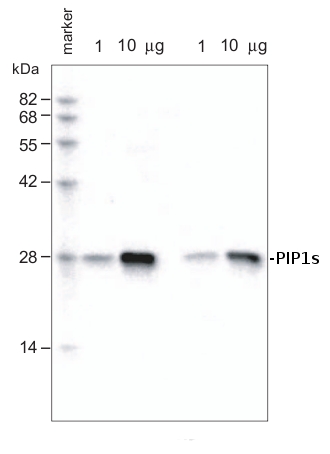
1 µg and 10 µg of crude membrane fraction/lane from Arabidopsis thaliana were separated on 12 % SDS-PAGE and blotted 1h to PVDF membrane (40 min. at 10 V using BioRad semidry transfer). Filters were blocked 1h with 5 % low-fat milk powder in TBS-T (0.05% Triton X.100). Membranes were washed 5 times with TBS-T, each time in a fresh polystyrene box and probed with anti-PIP1s ntibodies (diluted in 1: 500 (left panel) and 1: 1000 (right panel), AS09 489, and secondary anti-rabbit (1:2000, 1 h). All steps were performed in RT with agitation.
Application examples: 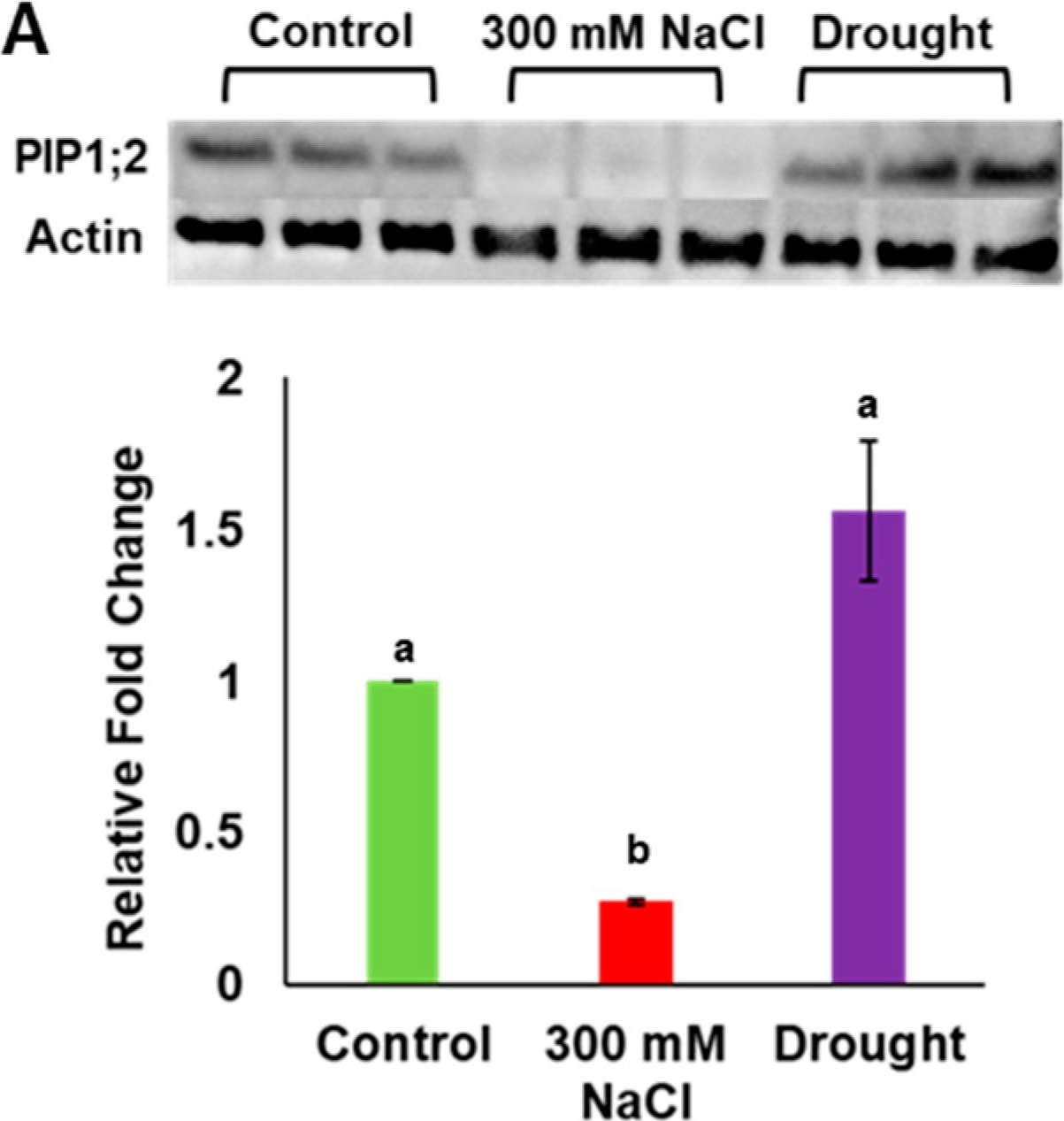
Reactant: Saccharomyces cerevisiae (Yeast)
Application: Western Blotting
Pudmed ID: 31121945
Journal: Genes (Basel)
Figure Number: 4A
Published Date: 2019-05-22
First Author: Patankar, H. V., Al-Harrasi, I., et al.
Impact Factor: 3.886
Open PublicationAnalysis of PdPIP1;2 protein expression in leaf and root tissues under drought and salinity conditions. Protein immunoblot image showing the levels of PdPIP1;2 protein accumulation in leaves (A) and roots (B) of date palm seedlings, grown under control, salinity and drought conditions of three biological replicates. The bar graph shows the mean of the relative fold change of accumulation (± SE, n = 3) in salinity and drought stress, compared to control conditions. Asterisks indicate a significant difference at p < 0.05.
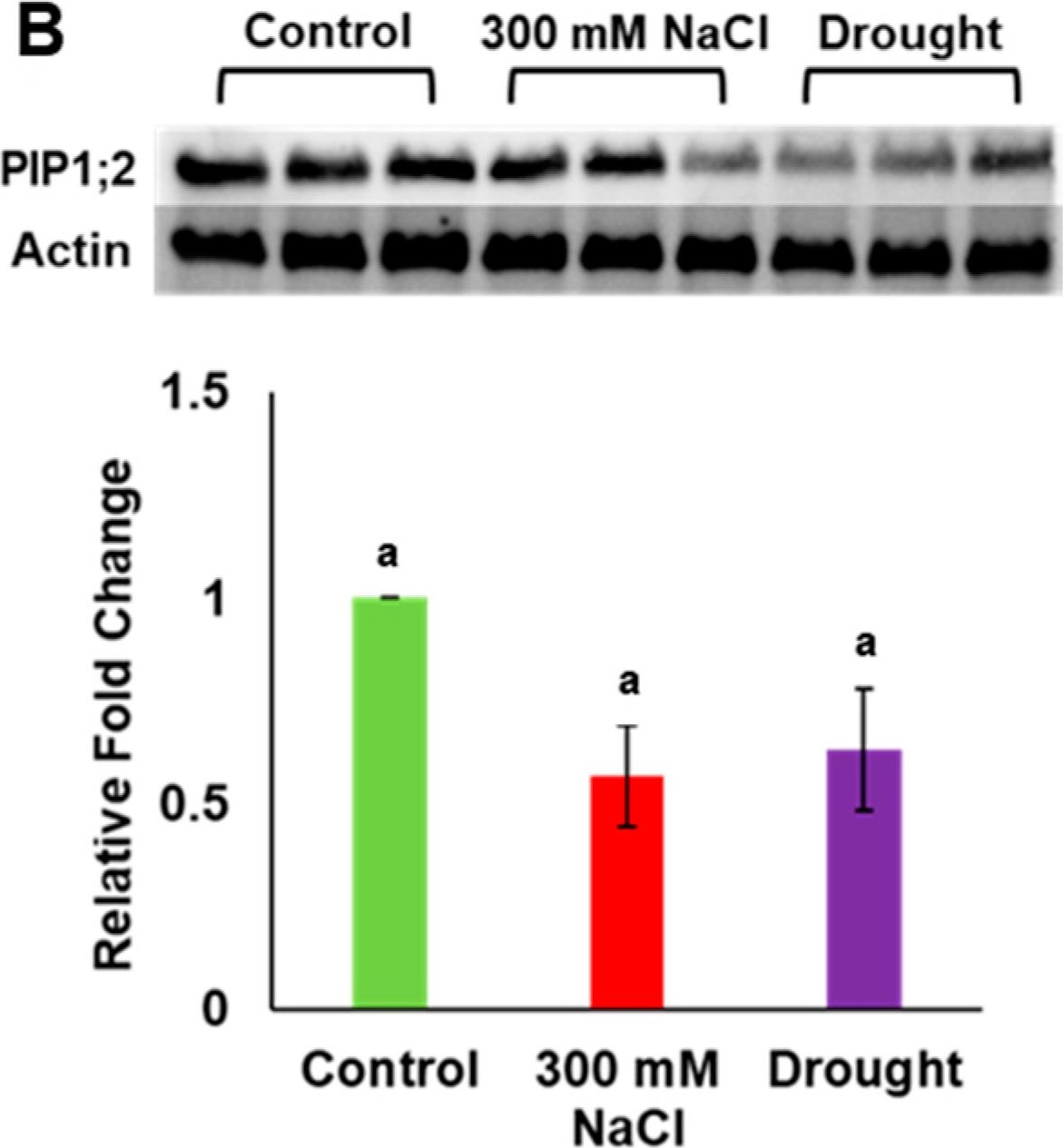
Reactant: Saccharomyces cerevisiae (Yeast)
Application: Western Blotting
Pudmed ID: 31121945
Journal: Genes (Basel)
Figure Number: 4B
Published Date: 2019-05-22
First Author: Patankar, H. V., Al-Harrasi, I., et al.
Impact Factor: 3.886
Open PublicationAnalysis of PdPIP1;2 protein expression in leaf and root tissues under drought and salinity conditions. Protein immunoblot image showing the levels of PdPIP1;2 protein accumulation in leaves (A) and roots (B) of date palm seedlings, grown under control, salinity and drought conditions of three biological replicates. The bar graph shows the mean of the relative fold change of accumulation (± SE, n = 3) in salinity and drought stress, compared to control conditions. Asterisks indicate a significant difference at p < 0.05.
- Additional Information
-
Additional information: 0.1 % sodium azide is added as preservative. For antibody re-suspending information check the tube lable.
Antibodies will detect target protein in a few µg of a crude preparation loaded per well. If purified preparations of vacuolar and plasma membranes are used, one µg load per well should be sufficient. PIP1;1-PIP1;5 isoforms can be detected in most tissues.
Additional information (application): Protein or membrane sample should be treated at 70°C for 10 min before loading on the gel.
Diluted antibody solution can be used 2 to 3 times within one month if it contains 0.1 % sodium azide as preservative and is stored at -20ºC to -80ºC.
Antibody reacts also with PIP2 isoforms in Zea mays. - Background
-
Background: PIPs proteins are aquaporins which facilitate the transport of water and small neutral molecules across cell membrane. PIP1;2 is also designated as PIP1B.
- Product Citations
-
Selected references: Patankar et al. (2019). Functional Characterization of Date Palm Aquaporin Gene PdPIP1;2 Confers Drought and Salinity Tolerance to Yeast and Arabidopsis. Genes (Basel). 2019 May 22;10(5). pii: E390. doi: 10.3390/genes10050390.
Fernández-San Millán et al. (2018). Physiological Performance of Transplastomic Tobacco Plants Overexpressing Aquaporin AQP1 into Chloroplast Membranes. J Exp. Bot. ery148, https://doi.org/10.1093/jxb/ery148.
Pengelly et al. (2014). Transplastomic integration of a cyanobacterial bicarbonate transporter into tobacco chloroplasts. J Exp. Botany, doi:10.1093/jxb/eru156.
- Protocols
-
Agrisera Western Blot protocol and video tutorials
Protocols to work with plant and algal protein extracts
Agrisera Educational Posters CollectionMethod for isolation of plant plasma membranes
.jpg)
Courtesy of Dr. Masayoshi Maeshima, Laboratory of Cell Dynamics, Graduate School of Bioagricultural Sciences Nagoya University Nagoya, Japan
- Reviews:
-
Irene Granlund | 2011-11-21Work well at least in whole plant extract.

